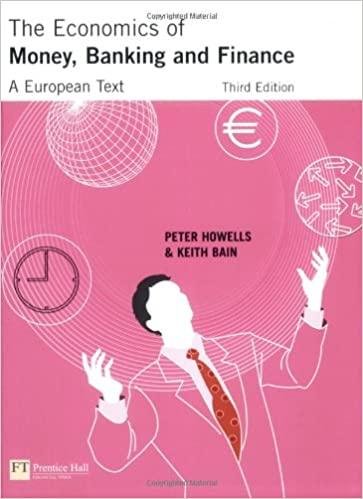Chapter 4: Carlsberg in Emergency Markets
1.) Conduct a SWOT analysis
2.) Emphasize the firm's competitve advantage

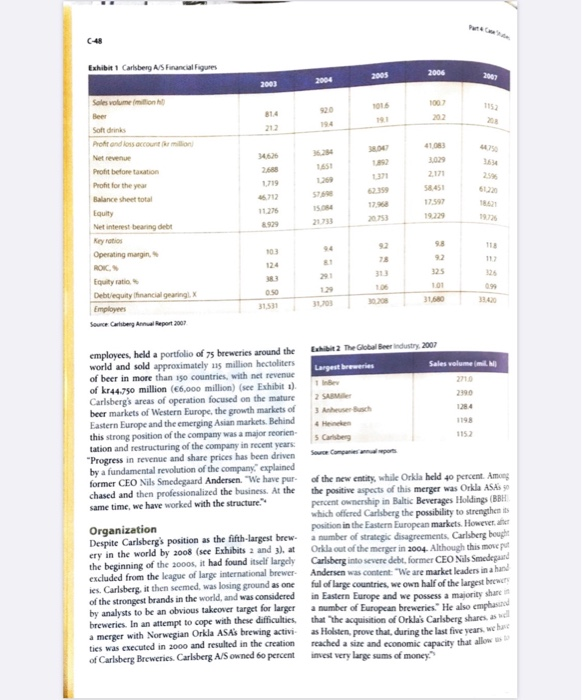
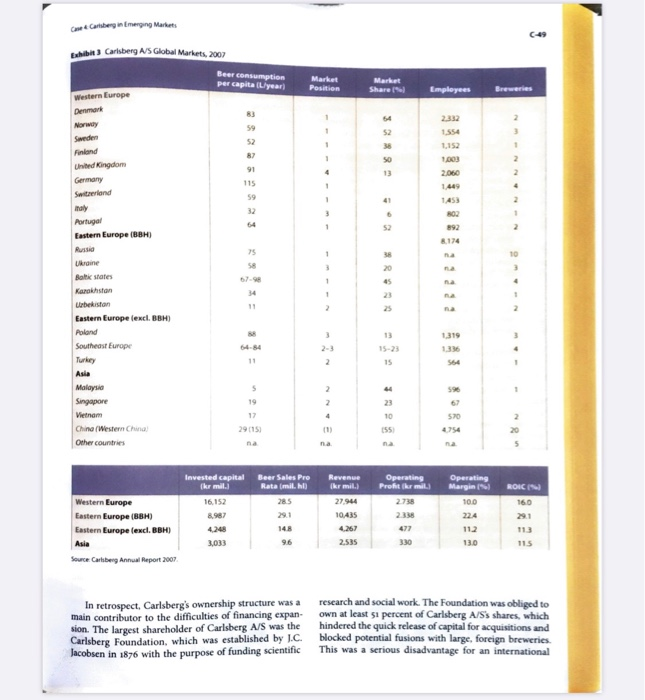
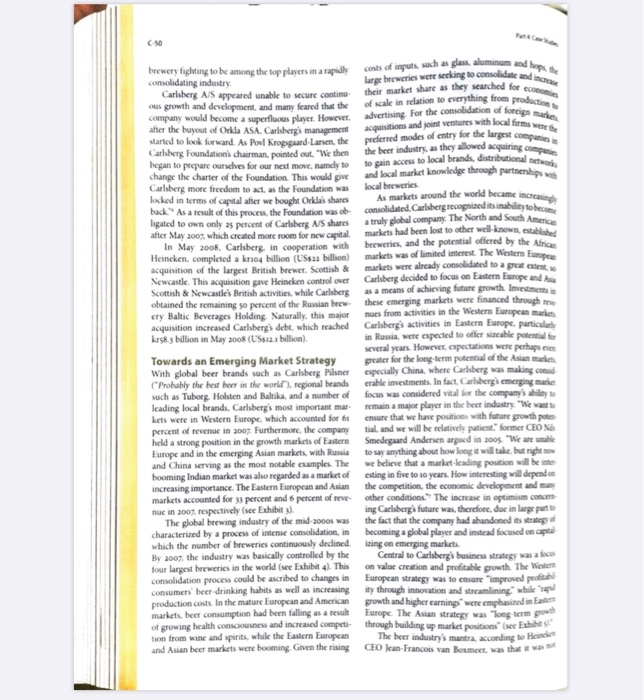
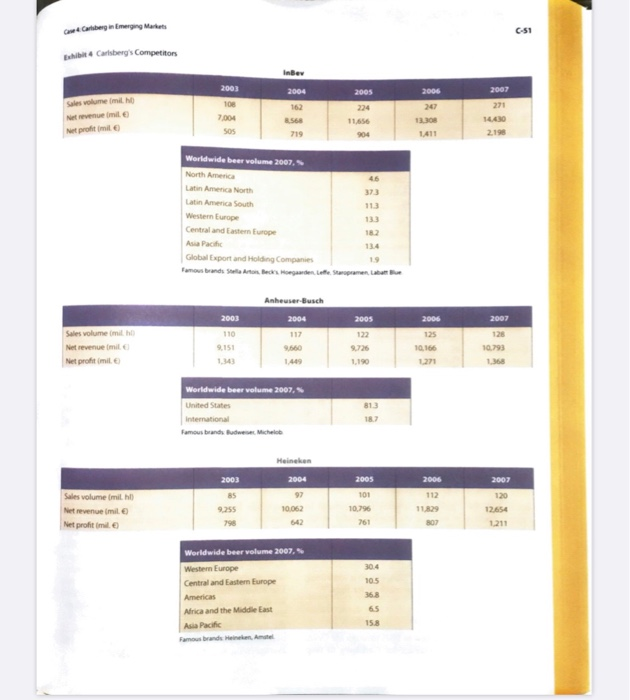
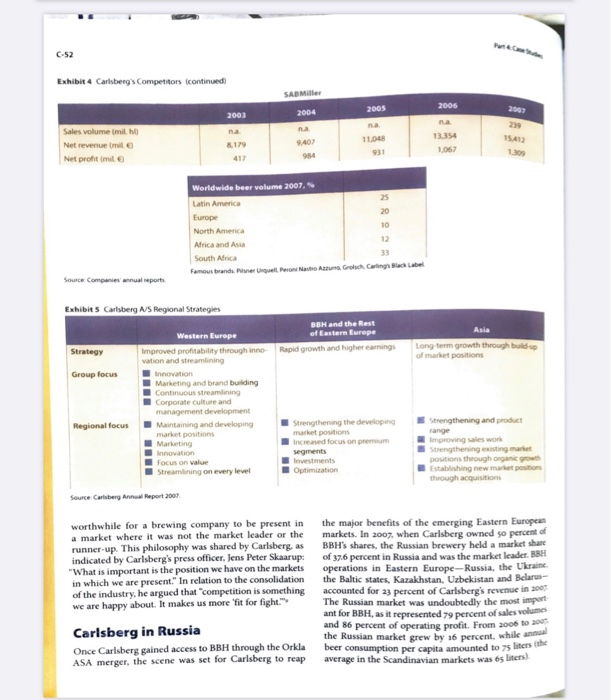
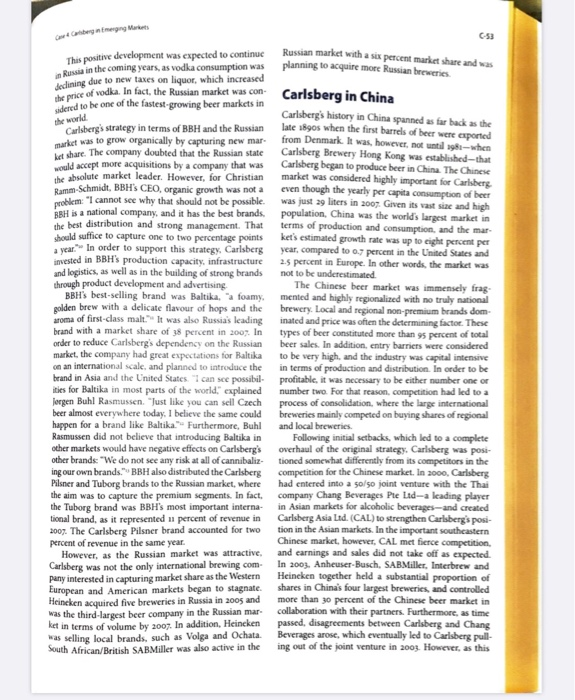
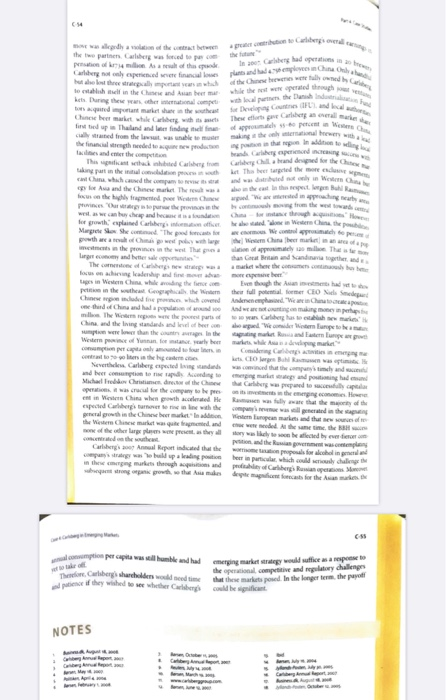
Case Coberg in Emerging Markets CASE 4 Slvey Publishing Carlsberg in Emerging Markets A breeze of optimism blew through the office of Carlsberg became an obvious takeover target and was also at risk ASS CEO, Jorgen Buhl Rasmussen. After finally gain ing 100 percent control over the giant Russian brewery of being cornered as a small regional player. Nonetheless Baltic Beverages Holding (BBH), and with the invest in 2008 as the first decade of the millennium neared an ments in Western China beginning to hear fruit, the end. Carlsberg was the filth-largest brewery in the world newly appointed CEO was confident that the Danish in terms of volume produced. Much of this reversal of brewing company's intensified focus on emerging mar. fortune could be attributed to the company's emerging Lets would pay off. The company was counting on tap market focus ping the massive potential in emerging markets in order Despite Buhl Rasmussen's optimism about the future. to achieve a much-needed reduction in its dependency the real question was how Carlsberg A/S could success on the maturing and stagnating Western European beer fully continue to capitaline on its growing engagement markets, which accounted for a full 6 percent of the in emerging markets. "We don't know how large the Chinese market will be in five years, and I don't know company's revenue in 2007 if China can become a new BBH." the CEO explained Indeed, Carlsberg's emerging market efforts had "but it is definitely not impossible, as the market is come a long way. In the Russian market, which was con enormous. It was no surprise that competition was sidered to be one of the fastest-growing beer markets becoming increasingly ficrce in this booming emerging in the world, Carlsberg enjoyed market leader status market, and history had clearly proven that doing busi through its ownership of BBH. In that market, it had a ness successfully in this market required unconventional sales volume of approximately 23 million hectoliters of approaches, beer in 2007 and revenue of kr 9 billion (US$1.8 billion) As for the highly promising Chinese market, which was regarded as the world's largest beer market in terms of Introducing Carlsberg A/S population and size, the Danish company had achieved a The successful course and strategy which Carisberg has 55 percent market share in the western parts of the coun pursued in recent years will remain basically the same try, and it operated 20 brewery plants in China with close no matter what. The strategy has proved its worth with 105.000 employees. In fact, as Carlsberg recognized that growth and better results, and it is now strongly rooted in the European markets would eventually reach a point of our organisation. Our business is thus to focus on the beer Saturation, the aim of the Chinese investments was to markets in Western Europe. Eastern Europe and Asia. Create a platform for future growth and revenue - Carlsberg A/S CEO. Jorgen Buhl Rasmussen The outlook for Carlsberg had not always been as bright as it appeared by 2008. Carlsberg's emerging As the fifth largest brewing company in the world. market strategy had taken a long and winding road. For Carlsberg A/Ss vision was "our brands will be the con instance. Carlsberg's acquisition of the BBH shares was sumer's first choice, and we will lead our industry in the result of a troubled and expensive partnership with profitability and growth through a culture of quality innovation and continuous improvement. Moreover, Norwegian Orkla ASA. In addition, before Carlsberg Carlsberg saw itself as "probably the best beer company had become successful in the western provinces of China, in the world." the company had spent plenty of valuable time and The core businesses of Carlsberg A/S were brewing resources trying to enter the rich provinces of southeast marketing and selling beer. In 1847. C. Jacobsen opened ern China, a strategy that had failed. Furthermore, in the the doors of Carlsberg A/S's first brewery in Copenhagen, Carly 2000s, Carlsberg was on the brink of being reduced Denmark, and the first foreign brewery was established to a secondary player in the global beer market-as the in Malawi in 1968. In 2007, the company had 33.000 consolidation of the industry proceeded, Carlsberg A/S Alimente Prudence Michael W. Hansen. PhD Student Marcus Moler Lanen und Puner Toten Pedersen wote the case selechy pronde material for das Lime. The authors do not intend to ludrate either effective et ineffective handling of a managerul situation. The authors may have duguel cerem run what its written perman Reproduct of this material and covered under thorace by any production rights resantrat 30. Richard by Sched on Foundation One time perm...ce to reproduce granted by Richard School of Buses found Exhibir 1 Carlsberg AS Financial figures 2005 2006 2003 2004 20 814 212 100 202 34,626 1719 Sales volume milion Beer Soft drinks Poft and loss account Net revenue Profit before taxation Profit for the year Balance sheet total Equity Net interest bearing debt Keyri Operating margin ROIC Equity ratio Debt/equity Thinancial gearingl. Employees Source Carlsberg Annual Report 2007 58.451 17.597 19.229 11275 98 118 103 124 320 101 0:50 employees, held a portfolio of 7s breweries around the N2 The Global Beer industry 2007 world and sold approximately 115 million hectoliters Largest breweries Sales volume (mil. of beer in more than 150 countries, with net revenue of kr44.750 million (6.000 million) (see Exhibit) 2710 Carlsberg's areas of operation focused on the mature 2 SAM 2390 beer markets of Western Europe, the growth markets of Eastern Europe and the emerging Asian markets. Behind 1198 this strong position of the company was a major reorien 5 Cabe tation and restructuring of the company in recent years. "Progress in revenue and share prices has been driven by a fundamental revolution of the company explained former CEO Nils Smedegaard Andersen. "We have pur of the new entity, while Orkla held 40 percent. Among chased and then professionalized the business. At the the positive aspects of this merger was Orkla ASAS same time, we have worked with the structure. percent ownership in Baltic Beverages Holdings (BBH which offered Carlsberg the possibility to strengthen it Organization position in the Eastern European markets. However, Despite Carlsbergs position as the fifth-largest brew a number of strategic disagreements, Carlsberg bought cry in the world by 2008 (see Exhibits 2 and 3), at Orkla out of the merger in 2004. Although this move put the beginning of the 2000s, it had found itself largely Carlsberg into severe debt, former CEO Nils Smedegaard excluded from the league of large international brewer Andersen was content: "We are market leaders in a hand ies. Carlsberg, it then seemed was losing ground as one ful of large countries, we own half of the largest bewers of the strongest brands in the world, and was considered in Eastern Europe and we possess a majority share by analysts to be an obvious takeover target for larger a number of European breweries." He also emphasirod breweries. In an attempt to cope with these difficulties that the acquisition of Orkla's Carlsberg shares, ad a merger with Norwegian Orkla ASAs brewing activitas Holsten, prove that during the last five years, what ties was executed in 2000 and resulted in the creation reached a size and economic capacity that allows of Carlsberg Breweries. Carlsberg A/S owned to percent invest very large sums of money. Cure Catherinnering Markets C-49 Exhibit 3 Carlsberg A/S Global Markets, 2007 Beer consumption per capita L/year Market Position Market Share Employees Breweries Western Europe Denmark 54 2332 2 59 52 36 50 13 1.152 1003 1 2 2 Sarden Finland United Kingdom Germany Switserland maly Portugal Eastern Europe (BBHI 91 115 59 1 1449 1453 1 3 6 1 64 1 52 2 8.174 25 10 3 58 3 20 4 23 2 13 1319 Ukraine Bok states Karakhstan Lurbekiston Eastern Europe (excl. BBH) Poland Southeast Europe Turkey Asia Malaysia Singapore Vietnam China (Western China Other countries 2-3 2 15 596 5 19 2 2 23 17 4 10 570 29115 10 4754 20 Invested capital krmili 16.152 8.987 Western Europe Eastern Europe (880 Eastern Europe (excl. BBH) RONCINI 160 Beer Sales Pro Rata (milho 285 29.1 148 96 Revenue krmill 27.944 10435 Operating Profit krmil) 2.738 2.338 477 330 Operating Marginal 100 224 112 13.0 113 Asia 3.033 2.535 Source Carlsberg Annual Report 2007 In retrospect, Carlsberg's ownership structure was a main contributor to the difficulties of financing expan- sion. The largest shareholder of Carlsberg A/S was the Carlsberg Foundation, which was established by J.C. Jacobsen in 1876 with the purpose of funding scientific research and social work. The Foundation was obliged to own at least 51 percent of Carlsberg A/S's shares, which hindered the quick release of capital for acquisitions and blocked potential fusions with large, foreign breweries. This was a serious disadvantage for an international costs of impulsach as glass, aluminum and hide large breweries were seeking to consolidated Carlsberg A/S appeared unable to secure contin their market share as they searched for of scale in relation to everything from production advertising For the consolidation of foreign mare acquisitions and joint ventures with local firms were the preferred modes of entry for the largest companies the beer industry, as they allowed acquiring.com to gain access to local brands distributional care As markets around the world became in brewery fighting to be among the top players in a rapidly consolidating industry ous growth and development, and many feared that the company would become a superfluous player. However after the buyout of Orkla ASA, Carlsberg's management started to look forward. As Povl Krogsgaard-Larsen, the Carlsberg Foundation's chairman, pointed out. "We then began to prepare ourselves for our next move, namely to change the charter of the Foundation. This would give and local market knowledge through partnerships Carlsberg more freedom to act as the Foundation was local breweries locked in terms of capital after we bought Orklas shares back. As a result of this process, the Foundation was ob consolidated. Carlsberg recognized its inability to become ligated to own only 25 percent of Carlsberg A/S shares a truly global company. The North and South America after May 2007, which created more room for new capital markets had been lost to other well-known established In May 2008, Carlsberg, in cooperation with breweries, and the potential offered by the Africe Heineken, completed a kr104 billion (USsa2 billion) markets was of limited interest. The Western Europe acquisition of the largest British brewer. Scottish & markets were already consolidated to a great extent, Newcastle. This acquisition gave Heineken control over Carlsberg decided to focus on Eastern Europe and A Scottish & Newcastles British activities, while Carlsberg as a means of achieving future growth Investments obtained the remaining 50 percent of the Russian brew these emerging markets were financed through the cry Baltic Beverages Holding, Naturally, this major nues from activities in the Western European market acquisition increased Carlsberg's debt, which reached Carlsberg's activities in Eastern Europe, particularly kr58.3 billion in May 2008 (US$12.7 billion). in Russia, were expected to offer sizcable potential for several years. However, expectations were perhaps even Towards an Emerging Market Strategy greater for the long-term potential of the Asianmark With global beer brands such as Carlsberg Pilsner especially China, where Carlsberg was making.com (Probably the best beer in the world. regional brands erable investments. In fact, Carlsbergi emerging market such as Tuborg, Holsten and Baltika, and a number of focus was considered vital for the company's ability to leading local brands, Carlsberg's most important mar remain a major player in the beer industry. "We want kets were in Western Europe, which accounted for ensure that we have positions with future growth potes percent of revenue in 2007. Furthermore, the company tial, and we will be relatively patient, former CEO held a strong position in the growth markets of Eastern Smedegaard Andersen argued in 2005. "We are unable Europe and in the emerging Asian markets, with Russia to say anything about how long it will take, but right now and China serving as the most notable examples. The we believe that a market-leading position will be me booming Indian market was also regarded as a market of esting in five to 10 years. How interesting will depende increasing importance. The Eastern European and Asian the competition, the economic development and markets accounted for 33 percent and 6 percent of reve other conditions. The increase in optimism concm nue in 2007. respectively (see Exhibit 3) ing Carlsberg's future was therefore, duc in large parte The global brewing industry of the mid-2000s was the fact that the company had abandoned its strategy of characterized by a process of intense consolidation, in becoming a global player and instead focused on capital which the number of breweries continuously declined iring on emerging markets. By 2007, the industry was basically controlled by the Central to Carlsberg's business strategy was a foc four largest breweries in the world (see Exhibit 4). This on value creation and profitable growth. The Westers consolidation process could be ascribed to changes in European strategy was to ensure improved profil consumers' beer-drinking habits as well as increasing ity through innovation and streamlining whilpa production costs. In the mature European and American growth and higher earnings were emphasized in Easter markets, beer consumption had been falling as a result Europe. The Asian strategy was long-term groot of growing health consciousness and increased competithrough building up market positions" (see Ezhube tion from wine and spirits, while the Eastern European The beer industry's mantra, according to Hincke and Asian beer markets were booming. Given the rising CEO Jean-Francois van Boxmeer, was that it was 6-51 Cuore Cabernegg Markets bit Catsberg's Competitors Inbew 2004 2005 2005 Sales volume mine veemile ut profile 2003 108 7.004 SOS 162 8.568 719 20 13.300 1411 11.656 2007 221 14430 2.190 Worldwide beer volume 2007, 5 North America Latin America North 373 Latin America South Western Europe 133 Central and Eastern Europe Asia Pacific Global Esport and Holding Companies Famous brands Stor Beck Hegde Late Starogramerah Anheuser Busch 2003 2004 117 110 Sales volume mit Net revenue mil Net profit (mile 2005 122 9.726 1,190 2006 125 10.166 27 2007 128 10.793 1368 9.151 Worldwide beer volume 2007, 5 United States International Famous brands. Bude Michel 813 187 Heineken 2005 2006 2007 112 Sales volume milho Net revenue mil. Net profit mile 2003 85 9.255 798 2004 97 10.062 542 101 10,796 761 120 12.654 1211 807 105 Worldwide beer volume 2007, Western Europe Central and Eastern Europe Americas Africa and the Middle East Asia Pacific Famous branden. Amel 65 15.8 the world This positive development was expected to continue Russian market with a six percent market share and was planning to acquire more Russian breweries in Russia in the coming years, as vodka consumption was declining due to new taxes on liquor, which increased dhe price of vodka. In fact, the Russian market was con Carlsberg in China sidered to be one of the fastest-growing beer markets in Carlsberg's history in China spanned as far back as the Carlsbergs strategy in terms of BBH and the Russian late 1890s when the first barrels of beer were exported market was to grow organically by capturing new mar from Denmark. It was, however, not until 1980-when hot share. The company doubted that the Russian state Carlsberg Brewery Hong Kong was established-that would accept more acquisitions by a company that was Carlsberg began to produce beer in China The Chines the absolute market leader. However, for Christian market was considered highly important for Carlsberg Ramm-Schmidt, BBH'S CEO, organic growth was not a even though the yearly per capita consumption of beer problem: "I cannot see why that should not be possible was just 29 liters in 2007. Given its vast size and high BBH is a national company, and it has the best brands. population, China was the world's largest market in the best distribution and strong management. That terms of production and consumption, and the mar- should suffice to capture one to two percentage points ket's estimated growth rate was up to eight percent per a year. In order to support this strategy. Carlsberg year, compared to 0.7 percent in the United States and invested in BBH's production capacity, infrastructure 2.5 percent in Europe. In other words, the market was and logistics, as well as in the building of strong brands not to be underestimated through product development and advertising The Chinese beer market was immensely frag- BBH's best-selling brand was Baltika, a foamy. mented and highly regionalized with no truly national golden brew with a delicate flavour of hops and the brewery. Local and regional non-premium brands dom aroma of first-class malt. It was also Russia's leading inated and price was often the determining factor. These brand with a market share of 38 percent in 2007. In types of beer constituted more than 95 percent of total order to reduce Carlsbergs dependency on the Russian beer sales. In addition, entry barriers were considered market, the company had great expectations for Baltika to be very high, and the industry was capital intensive on an international scale and planned to introduce the in terms of production and distribution. In order to be brand in Asia and the United States. "I can see possibil profitable, it was necessary to be either number one or ities for Baltika in most parts of the world." explained number two. For that reason, competition had led to a Jorgen Buhl Rasmussen. "Just like you can sell Czech process of consolidation, where the large international beer almost everywhere today. I believe the same could breweries mainly competed on buying shares of regional happen for a brand like Baltika. Furthermore, Buhl and local breweries. Rasmussen did not believe that introducing Baltika in Following initial setbacks, which led to a complete other markets would have negative effects on Carlsberg's overhaul of the original strategy. Carlsberg was post- other brands: "We do not see any risk at all of cannibaliz tioned somewhat differently from its competitors in the ing our own brands BBH also distributed the Carlsberg competition for the Chinese market. In 2000, Carlsberg Pilsner and Tuborg brands to the Russian market, where had entered into a 50/50 joint venture with the Thai the aim was to capture the premium segments. In fact, company Chang Beverages Pte Ltd-a leading player the Tuborg brand was BBH's most important interna in Asian markets for alcoholic beverages-and created tional brand, as it represented a percent of revenue in Carlsberg Asia Lad. (CAL) to strengthen Carlsberg's posi- 2007. The Carlsberg Pilsner brand accounted for two tion in the Asian markets. In the important southeastern percent of revenue in the same year. Chinese market, however, CAL met fierce competition However, as the Russian market was attractive, and earnings and sales did not take off as expected Carlsberg was not the only international brewing com In 2003. Anheuser-Busch, SABMiller, Interbrew and Heineken together held a substantial proportion of pany interested in capturing market share as the Western European and American markets began to stagnate. shares in China's four largest breweries, and controlled Heineken acquired five breweries in Russia in 2005 and more than 30 percent of the Chinese beer market in collaboration with their partners. Furthermore, as time was the third-largest beer company in the Russian mar ket in terms of volume by 2007. In addition, Heineken passed, disagreements between Carlsberg and Chang was selling local brands, such as Volga and Ochata. Beverages arose, which eventually led to Carlsberg pull- South African/British SABMiller was also active in the ing out of the joint venture in 2003. However, as this Tutup Thailand and funding from the two parten Carlsberg was forced to per com in As a result of the The part whited Carlsberg from care and desped for the Chine aking part in the initial condition perust what has beer targeted the more da Cart Chen, which caused the company to review and distributed to in Worten y e Ana and the Chinese market. There wabenthe cat in the expect forgen Buhl focus on the highly fragmented peer Wiedere Chinese puede tented practing arty pincetas prex the provinces in the coming from the worden well as we can buy chew and became Show tango for growth plained Carlsberg inom offered one in Western Chinathe Marge She "The powth are a techniswet polyhlung Wiese Chineet market in an arcade me the prochwest The son of polyamie The lungs can be than and Sandtogter and The comment of Cheg www.smart where the con focus en angladesh and her be tages in Western Chim while wording the time Even though the methode petite in the the Geographical the full potential former CHO Nile mele thund China and laten wettig mange the milliers the powered year Cathers as well China and the lining standard and level of negle Europe to be etter lange Westem of Yunan fly beer comune per capital and so fouinen et Color Black Neverthele. Caliber pested in standards und betonwedding eggs and had robil Christen director of the Chine Cabe prepared to succes peace was crocul for the company to see is the emerging.com en in Western China when growth accede expected Cabergstume me in line with come will generated in the wware that the way of the dai Chane tearerit thilae We furopean and that we were the Westem Chinese market w market was quite acted and Carlsberg Annual Report indicated that the womens forleding petition and the permet compagull plans pot fer la particular ich could only high ins through potations acaklarg: Sanna when out that des de licences for the end comption per capita wall humble and had emerging market strategy would suffice as a report Theron Cuberg shurchilders would need time for bese markets pobed. In the longer term, the payoff the operational competitive and regulatwy challenges if they wished to see whether Caliber could be glicant NOTES Case Coberg in Emerging Markets CASE 4 Slvey Publishing Carlsberg in Emerging Markets A breeze of optimism blew through the office of Carlsberg became an obvious takeover target and was also at risk ASS CEO, Jorgen Buhl Rasmussen. After finally gain ing 100 percent control over the giant Russian brewery of being cornered as a small regional player. Nonetheless Baltic Beverages Holding (BBH), and with the invest in 2008 as the first decade of the millennium neared an ments in Western China beginning to hear fruit, the end. Carlsberg was the filth-largest brewery in the world newly appointed CEO was confident that the Danish in terms of volume produced. Much of this reversal of brewing company's intensified focus on emerging mar. fortune could be attributed to the company's emerging Lets would pay off. The company was counting on tap market focus ping the massive potential in emerging markets in order Despite Buhl Rasmussen's optimism about the future. to achieve a much-needed reduction in its dependency the real question was how Carlsberg A/S could success on the maturing and stagnating Western European beer fully continue to capitaline on its growing engagement markets, which accounted for a full 6 percent of the in emerging markets. "We don't know how large the Chinese market will be in five years, and I don't know company's revenue in 2007 if China can become a new BBH." the CEO explained Indeed, Carlsberg's emerging market efforts had "but it is definitely not impossible, as the market is come a long way. In the Russian market, which was con enormous. It was no surprise that competition was sidered to be one of the fastest-growing beer markets becoming increasingly ficrce in this booming emerging in the world, Carlsberg enjoyed market leader status market, and history had clearly proven that doing busi through its ownership of BBH. In that market, it had a ness successfully in this market required unconventional sales volume of approximately 23 million hectoliters of approaches, beer in 2007 and revenue of kr 9 billion (US$1.8 billion) As for the highly promising Chinese market, which was regarded as the world's largest beer market in terms of Introducing Carlsberg A/S population and size, the Danish company had achieved a The successful course and strategy which Carisberg has 55 percent market share in the western parts of the coun pursued in recent years will remain basically the same try, and it operated 20 brewery plants in China with close no matter what. The strategy has proved its worth with 105.000 employees. In fact, as Carlsberg recognized that growth and better results, and it is now strongly rooted in the European markets would eventually reach a point of our organisation. Our business is thus to focus on the beer Saturation, the aim of the Chinese investments was to markets in Western Europe. Eastern Europe and Asia. Create a platform for future growth and revenue - Carlsberg A/S CEO. Jorgen Buhl Rasmussen The outlook for Carlsberg had not always been as bright as it appeared by 2008. Carlsberg's emerging As the fifth largest brewing company in the world. market strategy had taken a long and winding road. For Carlsberg A/Ss vision was "our brands will be the con instance. Carlsberg's acquisition of the BBH shares was sumer's first choice, and we will lead our industry in the result of a troubled and expensive partnership with profitability and growth through a culture of quality innovation and continuous improvement. Moreover, Norwegian Orkla ASA. In addition, before Carlsberg Carlsberg saw itself as "probably the best beer company had become successful in the western provinces of China, in the world." the company had spent plenty of valuable time and The core businesses of Carlsberg A/S were brewing resources trying to enter the rich provinces of southeast marketing and selling beer. In 1847. C. Jacobsen opened ern China, a strategy that had failed. Furthermore, in the the doors of Carlsberg A/S's first brewery in Copenhagen, Carly 2000s, Carlsberg was on the brink of being reduced Denmark, and the first foreign brewery was established to a secondary player in the global beer market-as the in Malawi in 1968. In 2007, the company had 33.000 consolidation of the industry proceeded, Carlsberg A/S Alimente Prudence Michael W. Hansen. PhD Student Marcus Moler Lanen und Puner Toten Pedersen wote the case selechy pronde material for das Lime. The authors do not intend to ludrate either effective et ineffective handling of a managerul situation. The authors may have duguel cerem run what its written perman Reproduct of this material and covered under thorace by any production rights resantrat 30. Richard by Sched on Foundation One time perm...ce to reproduce granted by Richard School of Buses found Exhibir 1 Carlsberg AS Financial figures 2005 2006 2003 2004 20 814 212 100 202 34,626 1719 Sales volume milion Beer Soft drinks Poft and loss account Net revenue Profit before taxation Profit for the year Balance sheet total Equity Net interest bearing debt Keyri Operating margin ROIC Equity ratio Debt/equity Thinancial gearingl. Employees Source Carlsberg Annual Report 2007 58.451 17.597 19.229 11275 98 118 103 124 320 101 0:50 employees, held a portfolio of 7s breweries around the N2 The Global Beer industry 2007 world and sold approximately 115 million hectoliters Largest breweries Sales volume (mil. of beer in more than 150 countries, with net revenue of kr44.750 million (6.000 million) (see Exhibit) 2710 Carlsberg's areas of operation focused on the mature 2 SAM 2390 beer markets of Western Europe, the growth markets of Eastern Europe and the emerging Asian markets. Behind 1198 this strong position of the company was a major reorien 5 Cabe tation and restructuring of the company in recent years. "Progress in revenue and share prices has been driven by a fundamental revolution of the company explained former CEO Nils Smedegaard Andersen. "We have pur of the new entity, while Orkla held 40 percent. Among chased and then professionalized the business. At the the positive aspects of this merger was Orkla ASAS same time, we have worked with the structure. percent ownership in Baltic Beverages Holdings (BBH which offered Carlsberg the possibility to strengthen it Organization position in the Eastern European markets. However, Despite Carlsbergs position as the fifth-largest brew a number of strategic disagreements, Carlsberg bought cry in the world by 2008 (see Exhibits 2 and 3), at Orkla out of the merger in 2004. Although this move put the beginning of the 2000s, it had found itself largely Carlsberg into severe debt, former CEO Nils Smedegaard excluded from the league of large international brewer Andersen was content: "We are market leaders in a hand ies. Carlsberg, it then seemed was losing ground as one ful of large countries, we own half of the largest bewers of the strongest brands in the world, and was considered in Eastern Europe and we possess a majority share by analysts to be an obvious takeover target for larger a number of European breweries." He also emphasirod breweries. In an attempt to cope with these difficulties that the acquisition of Orkla's Carlsberg shares, ad a merger with Norwegian Orkla ASAs brewing activitas Holsten, prove that during the last five years, what ties was executed in 2000 and resulted in the creation reached a size and economic capacity that allows of Carlsberg Breweries. Carlsberg A/S owned to percent invest very large sums of money. Cure Catherinnering Markets C-49 Exhibit 3 Carlsberg A/S Global Markets, 2007 Beer consumption per capita L/year Market Position Market Share Employees Breweries Western Europe Denmark 54 2332 2 59 52 36 50 13 1.152 1003 1 2 2 Sarden Finland United Kingdom Germany Switserland maly Portugal Eastern Europe (BBHI 91 115 59 1 1449 1453 1 3 6 1 64 1 52 2 8.174 25 10 3 58 3 20 4 23 2 13 1319 Ukraine Bok states Karakhstan Lurbekiston Eastern Europe (excl. BBH) Poland Southeast Europe Turkey Asia Malaysia Singapore Vietnam China (Western China Other countries 2-3 2 15 596 5 19 2 2 23 17 4 10 570 29115 10 4754 20 Invested capital krmili 16.152 8.987 Western Europe Eastern Europe (880 Eastern Europe (excl. BBH) RONCINI 160 Beer Sales Pro Rata (milho 285 29.1 148 96 Revenue krmill 27.944 10435 Operating Profit krmil) 2.738 2.338 477 330 Operating Marginal 100 224 112 13.0 113 Asia 3.033 2.535 Source Carlsberg Annual Report 2007 In retrospect, Carlsberg's ownership structure was a main contributor to the difficulties of financing expan- sion. The largest shareholder of Carlsberg A/S was the Carlsberg Foundation, which was established by J.C. Jacobsen in 1876 with the purpose of funding scientific research and social work. The Foundation was obliged to own at least 51 percent of Carlsberg A/S's shares, which hindered the quick release of capital for acquisitions and blocked potential fusions with large, foreign breweries. This was a serious disadvantage for an international costs of impulsach as glass, aluminum and hide large breweries were seeking to consolidated Carlsberg A/S appeared unable to secure contin their market share as they searched for of scale in relation to everything from production advertising For the consolidation of foreign mare acquisitions and joint ventures with local firms were the preferred modes of entry for the largest companies the beer industry, as they allowed acquiring.com to gain access to local brands distributional care As markets around the world became in brewery fighting to be among the top players in a rapidly consolidating industry ous growth and development, and many feared that the company would become a superfluous player. However after the buyout of Orkla ASA, Carlsberg's management started to look forward. As Povl Krogsgaard-Larsen, the Carlsberg Foundation's chairman, pointed out. "We then began to prepare ourselves for our next move, namely to change the charter of the Foundation. This would give and local market knowledge through partnerships Carlsberg more freedom to act as the Foundation was local breweries locked in terms of capital after we bought Orklas shares back. As a result of this process, the Foundation was ob consolidated. Carlsberg recognized its inability to become ligated to own only 25 percent of Carlsberg A/S shares a truly global company. The North and South America after May 2007, which created more room for new capital markets had been lost to other well-known established In May 2008, Carlsberg, in cooperation with breweries, and the potential offered by the Africe Heineken, completed a kr104 billion (USsa2 billion) markets was of limited interest. The Western Europe acquisition of the largest British brewer. Scottish & markets were already consolidated to a great extent, Newcastle. This acquisition gave Heineken control over Carlsberg decided to focus on Eastern Europe and A Scottish & Newcastles British activities, while Carlsberg as a means of achieving future growth Investments obtained the remaining 50 percent of the Russian brew these emerging markets were financed through the cry Baltic Beverages Holding, Naturally, this major nues from activities in the Western European market acquisition increased Carlsberg's debt, which reached Carlsberg's activities in Eastern Europe, particularly kr58.3 billion in May 2008 (US$12.7 billion). in Russia, were expected to offer sizcable potential for several years. However, expectations were perhaps even Towards an Emerging Market Strategy greater for the long-term potential of the Asianmark With global beer brands such as Carlsberg Pilsner especially China, where Carlsberg was making.com (Probably the best beer in the world. regional brands erable investments. In fact, Carlsbergi emerging market such as Tuborg, Holsten and Baltika, and a number of focus was considered vital for the company's ability to leading local brands, Carlsberg's most important mar remain a major player in the beer industry. "We want kets were in Western Europe, which accounted for ensure that we have positions with future growth potes percent of revenue in 2007. Furthermore, the company tial, and we will be relatively patient, former CEO held a strong position in the growth markets of Eastern Smedegaard Andersen argued in 2005. "We are unable Europe and in the emerging Asian markets, with Russia to say anything about how long it will take, but right now and China serving as the most notable examples. The we believe that a market-leading position will be me booming Indian market was also regarded as a market of esting in five to 10 years. How interesting will depende increasing importance. The Eastern European and Asian the competition, the economic development and markets accounted for 33 percent and 6 percent of reve other conditions. The increase in optimism concm nue in 2007. respectively (see Exhibit 3) ing Carlsberg's future was therefore, duc in large parte The global brewing industry of the mid-2000s was the fact that the company had abandoned its strategy of characterized by a process of intense consolidation, in becoming a global player and instead focused on capital which the number of breweries continuously declined iring on emerging markets. By 2007, the industry was basically controlled by the Central to Carlsberg's business strategy was a foc four largest breweries in the world (see Exhibit 4). This on value creation and profitable growth. The Westers consolidation process could be ascribed to changes in European strategy was to ensure improved profil consumers' beer-drinking habits as well as increasing ity through innovation and streamlining whilpa production costs. In the mature European and American growth and higher earnings were emphasized in Easter markets, beer consumption had been falling as a result Europe. The Asian strategy was long-term groot of growing health consciousness and increased competithrough building up market positions" (see Ezhube tion from wine and spirits, while the Eastern European The beer industry's mantra, according to Hincke and Asian beer markets were booming. Given the rising CEO Jean-Francois van Boxmeer, was that it was 6-51 Cuore Cabernegg Markets bit Catsberg's Competitors Inbew 2004 2005 2005 Sales volume mine veemile ut profile 2003 108 7.004 SOS 162 8.568 719 20 13.300 1411 11.656 2007 221 14430 2.190 Worldwide beer volume 2007, 5 North America Latin America North 373 Latin America South Western Europe 133 Central and Eastern Europe Asia Pacific Global Esport and Holding Companies Famous brands Stor Beck Hegde Late Starogramerah Anheuser Busch 2003 2004 117 110 Sales volume mit Net revenue mil Net profit (mile 2005 122 9.726 1,190 2006 125 10.166 27 2007 128 10.793 1368 9.151 Worldwide beer volume 2007, 5 United States International Famous brands. Bude Michel 813 187 Heineken 2005 2006 2007 112 Sales volume milho Net revenue mil. Net profit mile 2003 85 9.255 798 2004 97 10.062 542 101 10,796 761 120 12.654 1211 807 105 Worldwide beer volume 2007, Western Europe Central and Eastern Europe Americas Africa and the Middle East Asia Pacific Famous branden. Amel 65 15.8 the world This positive development was expected to continue Russian market with a six percent market share and was planning to acquire more Russian breweries in Russia in the coming years, as vodka consumption was declining due to new taxes on liquor, which increased dhe price of vodka. In fact, the Russian market was con Carlsberg in China sidered to be one of the fastest-growing beer markets in Carlsberg's history in China spanned as far back as the Carlsbergs strategy in terms of BBH and the Russian late 1890s when the first barrels of beer were exported market was to grow organically by capturing new mar from Denmark. It was, however, not until 1980-when hot share. The company doubted that the Russian state Carlsberg Brewery Hong Kong was established-that would accept more acquisitions by a company that was Carlsberg began to produce beer in China The Chines the absolute market leader. However, for Christian market was considered highly important for Carlsberg Ramm-Schmidt, BBH'S CEO, organic growth was not a even though the yearly per capita consumption of beer problem: "I cannot see why that should not be possible was just 29 liters in 2007. Given its vast size and high BBH is a national company, and it has the best brands. population, China was the world's largest market in the best distribution and strong management. That terms of production and consumption, and the mar- should suffice to capture one to two percentage points ket's estimated growth rate was up to eight percent per a year. In order to support this strategy. Carlsberg year, compared to 0.7 percent in the United States and invested in BBH's production capacity, infrastructure 2.5 percent in Europe. In other words, the market was and logistics, as well as in the building of strong brands not to be underestimated through product development and advertising The Chinese beer market was immensely frag- BBH's best-selling brand was Baltika, a foamy. mented and highly regionalized with no truly national golden brew with a delicate flavour of hops and the brewery. Local and regional non-premium brands dom aroma of first-class malt. It was also Russia's leading inated and price was often the determining factor. These brand with a market share of 38 percent in 2007. In types of beer constituted more than 95 percent of total order to reduce Carlsbergs dependency on the Russian beer sales. In addition, entry barriers were considered market, the company had great expectations for Baltika to be very high, and the industry was capital intensive on an international scale and planned to introduce the in terms of production and distribution. In order to be brand in Asia and the United States. "I can see possibil profitable, it was necessary to be either number one or ities for Baltika in most parts of the world." explained number two. For that reason, competition had led to a Jorgen Buhl Rasmussen. "Just like you can sell Czech process of consolidation, where the large international beer almost everywhere today. I believe the same could breweries mainly competed on buying shares of regional happen for a brand like Baltika. Furthermore, Buhl and local breweries. Rasmussen did not believe that introducing Baltika in Following initial setbacks, which led to a complete other markets would have negative effects on Carlsberg's overhaul of the original strategy. Carlsberg was post- other brands: "We do not see any risk at all of cannibaliz tioned somewhat differently from its competitors in the ing our own brands BBH also distributed the Carlsberg competition for the Chinese market. In 2000, Carlsberg Pilsner and Tuborg brands to the Russian market, where had entered into a 50/50 joint venture with the Thai the aim was to capture the premium segments. In fact, company Chang Beverages Pte Ltd-a leading player the Tuborg brand was BBH's most important interna in Asian markets for alcoholic beverages-and created tional brand, as it represented a percent of revenue in Carlsberg Asia Lad. (CAL) to strengthen Carlsberg's posi- 2007. The Carlsberg Pilsner brand accounted for two tion in the Asian markets. In the important southeastern percent of revenue in the same year. Chinese market, however, CAL met fierce competition However, as the Russian market was attractive, and earnings and sales did not take off as expected Carlsberg was not the only international brewing com In 2003. Anheuser-Busch, SABMiller, Interbrew and Heineken together held a substantial proportion of pany interested in capturing market share as the Western European and American markets began to stagnate. shares in China's four largest breweries, and controlled Heineken acquired five breweries in Russia in 2005 and more than 30 percent of the Chinese beer market in collaboration with their partners. Furthermore, as time was the third-largest beer company in the Russian mar ket in terms of volume by 2007. In addition, Heineken passed, disagreements between Carlsberg and Chang was selling local brands, such as Volga and Ochata. Beverages arose, which eventually led to Carlsberg pull- South African/British SABMiller was also active in the ing out of the joint venture in 2003. However, as this Tutup Thailand and funding from the two parten Carlsberg was forced to per com in As a result of the The part whited Carlsberg from care and desped for the Chine aking part in the initial condition perust what has beer targeted the more da Cart Chen, which caused the company to review and distributed to in Worten y e Ana and the Chinese market. There wabenthe cat in the expect forgen Buhl focus on the highly fragmented peer Wiedere Chinese puede tented practing arty pincetas prex the provinces in the coming from the worden well as we can buy chew and became Show tango for growth plained Carlsberg inom offered one in Western Chinathe Marge She "The powth are a techniswet polyhlung Wiese Chineet market in an arcade me the prochwest The son of polyamie The lungs can be than and Sandtogter and The comment of Cheg www.smart where the con focus en angladesh and her be tages in Western Chim while wording the time Even though the methode petite in the the Geographical the full potential former CHO Nile mele thund China and laten wettig mange the milliers the powered year Cathers as well China and the lining standard and level of negle Europe to be etter lange Westem of Yunan fly beer comune per capital and so fouinen et Color Black Neverthele. Caliber pested in standards und betonwedding eggs and had robil Christen director of the Chine Cabe prepared to succes peace was crocul for the company to see is the emerging.com en in Western China when growth accede expected Cabergstume me in line with come will generated in the wware that the way of the dai Chane tearerit thilae We furopean and that we were the Westem Chinese market w market was quite acted and Carlsberg Annual Report indicated that the womens forleding petition and the permet compagull plans pot fer la particular ich could only high ins through potations acaklarg: Sanna when out that des de licences for the end comption per capita wall humble and had emerging market strategy would suffice as a report Theron Cuberg shurchilders would need time for bese markets pobed. In the longer term, the payoff the operational competitive and regulatwy challenges if they wished to see whether Caliber could be glicant NOTES














